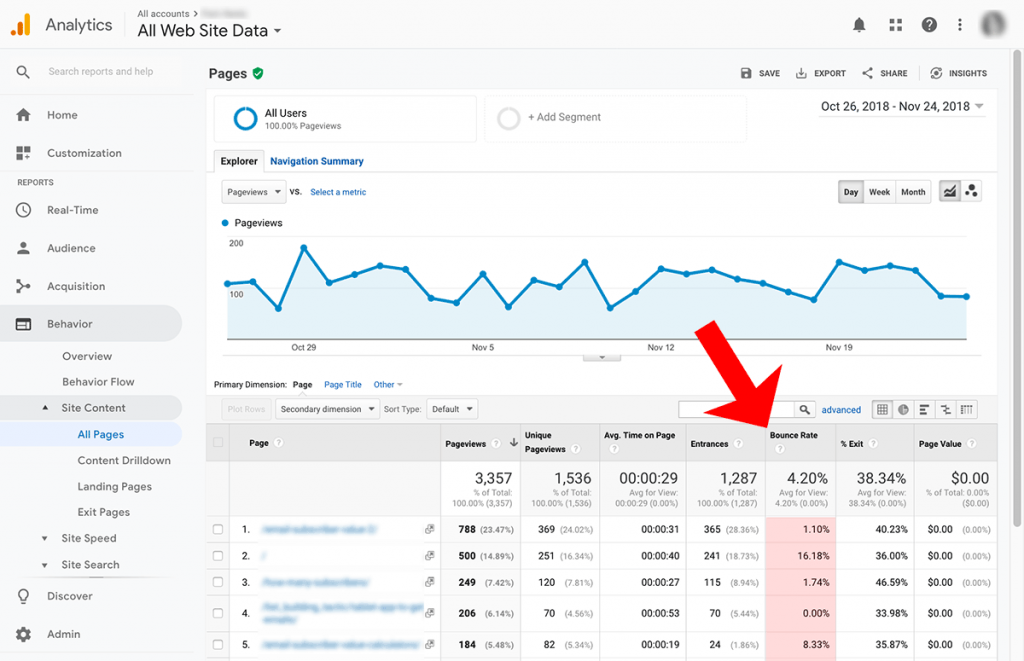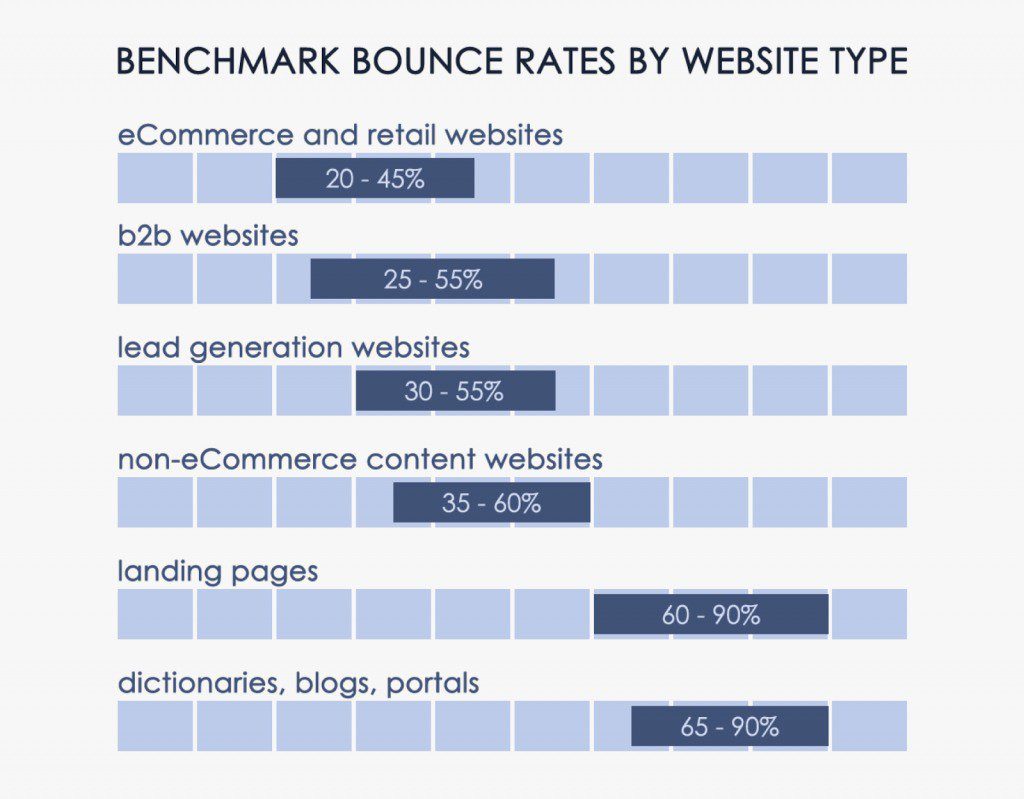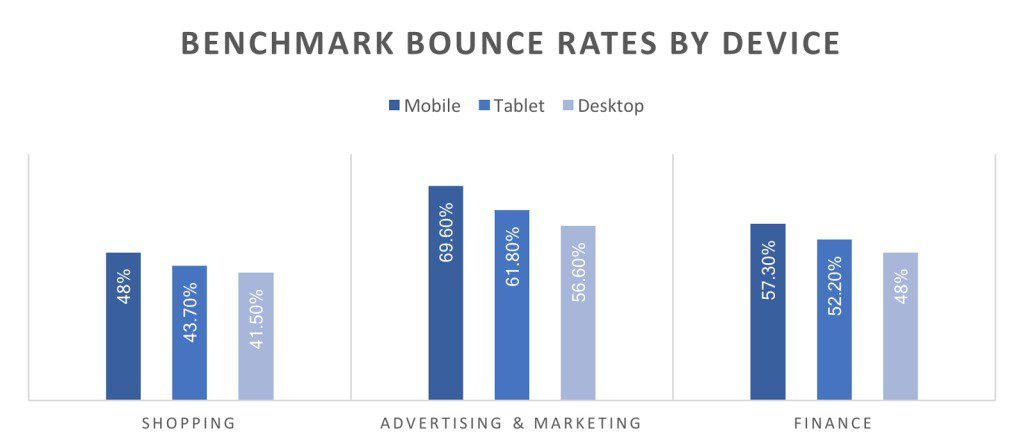Ever wondered about bounce rate when you’re looking at your Google Analytics reports?
It can seem like a scary metric – when most of us check our pages’ bounce rates, we see figures like 50%, 65%… maybe even 90%.
So are those figures good or bad? Are they cause for alarm, or not worth fussing about?
That’s what we’re going to answer here.
What Is Bounce Rate?
“A bounce is a single-page session on your site,” according to Google.
Bounce rate is the percentage of how many people come to a given page on your site and view only one page before they leave. So if 100 people came to a page, and 35 of them left the page without viewing any other pages, that page would have a 35% bounce rate.
Bounce rate can be measured page-by-page, or site-wide. You can find your site’s bounce rate by logging into your Google Analytics account and going to “Behavior” > “Site Content” > “All Pages”.

What Is a Good Bounce Rate?
Well, it depends… but here are some bounce rate benchmarks from a few recent studies:
- The agency Brafton says the average bounce rate is 58.18% according to their research.

- They also break out average bounce rate by industry:

- Customedialabs also breaks out bounce rates for different types of pages and sites:

- Of course, you can also expect bounce rates to change not just by industry and type of page, but also by channel. Here’s what those averages look like:

- And how bounce rates can vary by device:

Confused? Don’t be. The point of showing you all those charts is this: reports of “average” bounce rates are all over the place. There probably is no “average” bounce rate, in the same sense that there is no “average” user. Every site is unique, and there are hundreds of ways to slice and dice the data.
That said, we know a lot of you just want a hard number to measure your pages by. So here are several numbers:
- Anything over 85% is probably a “bad” bounce rate.
- Between 70-85% is in the red zone.
- Between 55-70% is average.
- Between 35-55% is good.
- Between 20-35% is very good.
- Anything below 20% is suspiciously good – check your Google Analytics settings and filter to make sure you are tracking real visitors.
And now, let’s move on to why you shouldn’t necessarily worry about bounce rate – even if yours is high.
Why Does Bounce Rate Matter?
Here’s the secret: It doesn’t… at least not as much as it appears to matter. Even Google’s page on bounce rate asks, “Is a high bounce rate a bad thing? It depends.”
Here’s why it depends: let’s say Visitor A arrives on a page of your website. They look at a headline and a header image and leave three seconds later. Then Visitor B comes to your website and spends 10 minutes carefully reading every word on a different page. Then they leave, having not clicked on any other page during their visit. Both of these visits are measured as a bounce.
Herein lies the limitation of bounce rate as a metric, and why most SEOs take it with about a pound of salt. If you just look at the bounce of those two events, you get no useful information.
Visitor A (the one who left after three seconds) didn’t find what they were looking for. The question is, why? Was it because…
- Your site loaded too slowly
- Your site looked untrustworthy to them
- They got a phone call
- Your page did such a good job of answering the visitor’s question that they don’t need to look any further
It could be any one of those things. And while there are other ways to find out why someone left a page, bounce rate alone doesn’t tell us.
Here’s another illustration of why bounce rate can be so meaningless: If you’re a solo entrepreneur with a one-page website, you are, by definition, going to have an extremely high bounce rate – like 100%. There is nowhere but that one page for people to go.
This is why bounce rate’s sister metric, dwell time, is so important. It is, arguably, a more meaningful metric than bounce rate.
What Is Dwell Time?
Dwell time is how long someone spends on a page before they go back to the search results. It is different than “Average Time on Page” because that measures how long someone spent on a page before they went anywhere else. “Anywhere else” could be back to the SERPs, on to another page on your site, or to the landing page of an ad on your site that they clicked.
These two metrics – time on page and dwell time – give you an important window into how people are using your pages.
Dwell time also appears to be a ranking signal. According to an article from Search Engine Roundtable late last year, “the head of Google Brain in Canada said that Google now uses click data for rankings. He said Google looks to train their AI models when ‘someone clicks on a page and stays on that page, when they go back’ and so on.”
That’s very interesting. Because – for all its fame – bounce rate may not be a ranking signal.
Is Bounce Rate a Ranking Signal?
Here we step into controversial territory. There are a lot of very smart SEOs that say bounce rate is not a ranking signal – aka, that the bounce rate for a given page or a whole website does not affect its position in the search results. There are a lot of other SEOs who say it is a ranking signal.
Truth is, there is no definitive answer on this either way. But here are some of the voices on either side of the argument:
- Barry Schwartz says bounce rates don’t affect rankings
- Research from SEMRush says they do
- Search Engine Watch explains how there is no consensus about whether bounce rate affects SERPs or not
Here’s the key takeaway from all those varied opinions: if bounce rates do affect search results, they can’t be affecting them a lot, or there would be more clarity about this. If this was a major ranking signal, there probably wouldn’t be so much confusion.
Also (and more likely), while bounce rate may correlate with higher rankings, it may not be the bounce rate itself – as a measured metric – that affects page ranking. Instead, a low bounce rate paired with higher rankings may be more of a symptom than a cause, in the same way that healthy people tend to have healthy complexions… but it is not their complexion that makes them healthy. As anybody who’s ever taken a statistics class knows, correlation is not causation.
The only thing bounce rate tells us for sure is that people aren’t clicking through to another page. If your goal for each page is to have it serve as the first step of a conversion funnel, then a low bounce rate is a problem. But if you just want a lot of people to see the page, then you could rely on other metrics like dwell time and time on page to tell you if people are engaging with the page or not.
This brings us to one specific – and very common – situation where bounce rate can reveal a serious problem.
Bounce Rate for SEO Versus Bounce Rate for PPC
So bounce rate isn’t the final word on how people are using your site… unless you want to have people take a second step after visiting that page.
If you’re an advertiser, you almost certainly want people to take a next step. You want them to place an order, download a report – whatever the conversion action is. You probably aren’t paying for clicks just to get more “eyeballs.” Data-driven marketers typically need conversions, not eyeballs (though smart retargeting campaigns can turn eyeballs into conversions over time).
So bounce rate probably does matter for most advertisers. But fortunately, it doesn’t appear to matter too much to the Google Ads Quality Score algorithm (bounce rates do not affect Quality Score).
How to Improve Bounce Rate
Assuming you don’t have a one-page website, and you want to keep your site’s bounce rates low, whether Google will reward you for it or not, how can you improve your website’s bounce rate?
Here are seven proven ways to do it:
1. Speed up your site. 40% of visitors will leave a site that takes more than three seconds to load.
“Knowing that most sites lose half of their visitors in the loading process, you could potentially double your lead generation by making improvements. What could a 2x increase in leads do for your business without spending extra money on ads or SEO? – Richard Beck
 2. Make your site mobile friendly. Super mobile friendly.
2. Make your site mobile friendly. Super mobile friendly.
It’s time for all of us to think “mobile first”. Head to Google Analytics and look at the bounce rates for your pages for mobile users. If you see big differences between how mobile and desktop users bounce, consider making those pages more mobile-friendly.
3. Redesign your site.
How old is the design of your site? Do you get compliments on how it looks? A stodgy site can make website users distrust it, or simply not like it. If the design isn’t pleasing and easy to understand, they may decide to leave the page before it has even finished loading.
4. Make sure the keywords people are using match what the page is about.
Ever heard the term “search intent”? It’s a critical concept in SEO today. Understanding how it affects bounce rates is simple: if people aren’t finding what they’re looking for on your site, they’ll leave.
5. Make your content more readable.
Nobody likes to crash into a wall of solid text. So if you aren’t using plenty of images, short paragraphs, subheaders, and bullet points, consider using them now.
Of course, readability isn’t just about how you break up text-based content. The content itself should be clear, engaging and actionable.
6. Be careful with pop-ups.
Sometimes called overlays, pop-ups are messages that block a reader’s view until the reader responds to them. Marketers love pop-ups because they work so well. Site visitors often hate them because they interrupt their experience. Consider testing whether or not pop-ups are affecting your pages’ bounce rates.
7. Have a clear call to action.
So if people aren’t clicking through to a second page… maybe it’s because you never asked them to. Having a call to action on key pages could help with that.
Conclusion
Bounce rate can be a helpful metric, but it’s not the final word on whether your pages are successful or not. Pay attention to your pages’ bounce rates – sure – but don’t obsess over them. Metrics like dwell time and time on page can often tell you more.
Image Credits
Feature Image: Unsplash / Alvan Nee
Image 1: Screenshot of Google Analytics account taken by the author, November 2018
Image 2-3: via Brafton
Image 4-6: via ConversionXL
Image 7: via Think with Google



